The bilayer cell membrane is a membranous structure, which consists of two phospholipid layers. Thus, a cell membrane also refers to a phospholipid bilayer membrane composed of many phospholipid molecules.
A structure of a phospholipid molecule consists of a hydrophilic head, a phosphate molecule, a glycerol molecule and two hydrophobic fatty acid tail. The phospholipid layer makes the plasma membrane selectively permeable by creating a barrier between interstitial and cytosolic fluid.
A prevalent model (Fluid mosaic model) was introduced to study a detailed or well-labelled structure of the cell membrane. Before proceeding to the fluid mosaic model, let us study the definition, integral components and functions of the cell membrane.
Content: Bilayer Cell Membrane
- Definition
- Composition of Bilayer Cell Membrane
- Functions of Cell Membrane
- Structure of Bilayer Cell Membrane
Definition of Bilayer Cell Membrane
It refers to the innermost layer after the cell wall, which possesses two-layers of phospholipid molecules, embedded proteins and extracellular carbohydrate. It acts as a semi-permeable membrane, where the phospholipid layer provides a chemical barrier between the cytoplasm and the surrounding environment. The bilayer cell membrane is also termed as “Plasma membrane”.

The cell membrane allows the exchange of only specific or selective molecules between the cell and surrounding, i.e. it serves as a selectively permeable membrane. A cell membrane primarily composed of 40% lipid, 60% protein and 1-10% of carbohydrate of dry cell weight.
Composition of Bilayer Cell Membrane
The composition of the cell membrane includes three essential biomolecules. Phospholipids and cholesterol molecules constitute the part of the lipid. Channel and carrier proteins are the membrane proteins, which constitute a significant part of a protein.
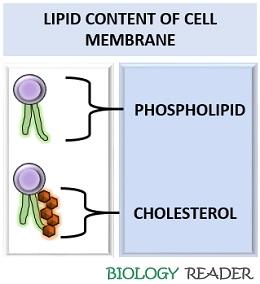
Phospholipid
It is a chemical substance or triglycerides making up the basic fabric of the cell membrane. In the year 1847, lecithin was the first phospholipid identified in the living tissues. The structural configuration of phospholipid consists of one hydrophilic head with a phosphate group and two hydrophobic tails containing fatty acid.
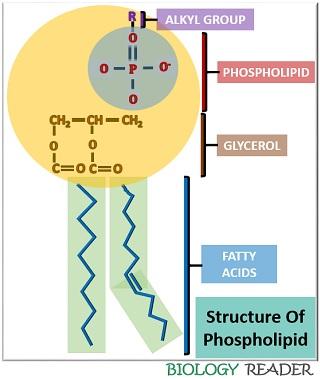
A glycerol molecule usually attaches the phosphate group and the chains of fatty acid. One chain of phospholipid molecule contains saturated fatty acid, whereas the other contains unsaturated fatty acid. Therefore, it shows an “Amphipathic property” by being both hydrophobic and hydrophilic.
Head of Phospholipid
A phospholipid molecule consists of the hydrophilic or polar head. Being hydrophilic, the head of a phospholipid molecule is water-loving, i.e. it readily interacts with water or polar solvents. The head of a phospholipid molecule contains a negatively charged phosphate group with an additional polar or charged alkyl or R-group.
The hydrophilic head is pointed outwards, which allow the exchange of polar molecules inside and outside the cell. According to the “Like dissolve like” rule, the hydrophilic head will dissolve readily in water by forming a hydrogen bond.
Tail of Phospholipid
A phospholipid molecule consists of a hydrophobic or non-polar tail. Being hydrophobic, the phospholipid molecule tail is water-hating, i.e. it poorly interacts with the water molecules. Thus, the polar molecules cannot cross the hydrophobic core easily. The tail of phospholipid is lipophilic, i.e. it readily interacts with the non-polar solvents.
The tail of the phospholipid molecule contains two fatty acid chains of about 14-24 carbon atoms. One tail of phospholipid is slightly bent due to the presence of unsaturated fatty acid with one or more cis-double bond. The other tail of phospholipid contains a long or straight chain of saturated fatty acid without a cis-double bond.
The phospholipid tail is pointed inwards because of its hydrophobic nature and associated with Vander Waal forces. If a phospholipid consists of a small tail, it forms a small lipid monolayer called “Micelle”.
Conversely, a phospholipid molecule with bulkier tails forms a large lipid bilayer sphere called “Liposome”. According to the “Like dissolve like” rule, the hydrophobic tail will not dissolve readily in water (pointed inwards), and they can only interact with each other.
Cholesterol
It can define as another lipid constituent, which is present in the core of the cell membrane. Cholesterol attaches alongside the hydrophobic tails of the phospholipid layer. Its structure consists of a polar head, planar steroid ring and non-polar hydrocarbon tail. The cholesterol molecules bind with the neighbouring phospholipid molecule via hydrogen-bond.
Cholesterol is also a crucial component of the cell membrane, which provides strength and firmness to the cell membrane at different temperatures. It maintains the fluid phase of the cell membrane at low temperature.
Cholesterol is composed of four fused rings of carbon with hydrogen atoms. These are hydrophobic, thus found between the hydrophobic tails of phospholipid.

Membrane Proteins
These constitute the major components of the cell membrane and are of two types:
- Integral
- Peripheral
In the membrane proteins, the non-polar amino acids associate directly with the lipid bilayer, whereas the polar amino acids are located inside.
Integral Protein
Integral membrane proteins or “transmembrane proteins” are the fixed and permanent structures incorporated within the cell membrane. It can be categorized into three kinds:
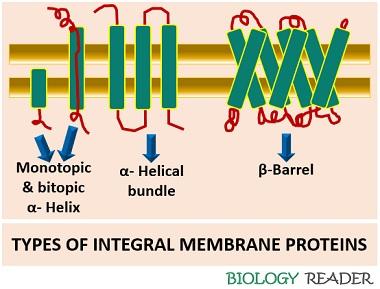
- Single or bitopic transmembrane α helix: It functions as a receptor molecule for the binding of selective molecules or ions. Bitopic transmembrane α helix also helps in the mechanism of cell recognition.
- Polytopic transmembrane α helical bundle: It performs three specific functions:
- Transporters: Acts as a carrier molecule for the active or passive transport of molecules or ions.
- Mediates enzyme catalysis: Acts as a helper molecule for the enzyme catalytic reactions.
- Receptor: It also acts as a receptor that allows binding of only specific molecules from the environment into the cytoplasm and induces a chemical reaction within the cell. Thus, α helical bundle plays a dual role by functioning as both cell receptor and ion channel.
- Polytopic transmembrane β barrel or Channel protein: It performs a functional role in the transportation of different molecules.
Peripheral Protein
These protein molecules are temporarily attached to the cell membrane. The peripheral protein attaches with the cell membrane via hydrophobic, electrostatic and non-covalent interactions. It dissociates at high pH and salt concentration. It is located either peripheral to the lipid membrane or the integral protein.
Carbohydrate
It is a third major component of the cell membrane present in the extracellular space called the glycocalyx. It basically consists of 2-60 monosaccharide units, and the structure of glycocalyx can be straight or branched.
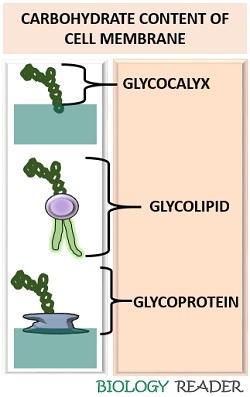
The association of carbohydrate molecules and membrane proteins form glycoproteins. A combination of a carbohydrate molecule and lipid molecule forms glycolipid.
Functions of Cell Membrane
A cell membrane performs many tasks, which can be understood by knowing the individual role of the particular component.
Membrane Protein Functions
- Membrane proteins help in the cell to cell attachment or intercellular joining.
- It plays a vital role in the enzyme-catalyzed metabolic pathways.
- Transports specific molecules or ions through active, passive and facilitated diffusion.
- It helps in cell recognition by inducing a chemical reaction within the cell.
- Membrane proteins also help in the cell anchorage or attachment, as they consist of some attachment sites for the cytoskeleton and extracellular matrix.
Phospholipids Functions
- It makes the cell membrane “semi or selectively permeable” by functioning as a barrier between the cytoplasm and extracellular environment.
- It restricts the passage of unwanted molecules.
Cholesterol Functions
- It maintains the membrane fluidity at low temperature.
- Cholesterol also prevents the hydrophobic fatty acid tails from solidification at a cold temperature.
- It prevents the passage of small molecules into the cell membrane.
- It keeps the phospholipid molecules intact.
Structure of Bilayer Cell Membrane
Fluid mosaic is the best model to explain the structure of the bilayer cell membrane. It was introduced in the year 1972 by two scientists named Singer and Nicolson.
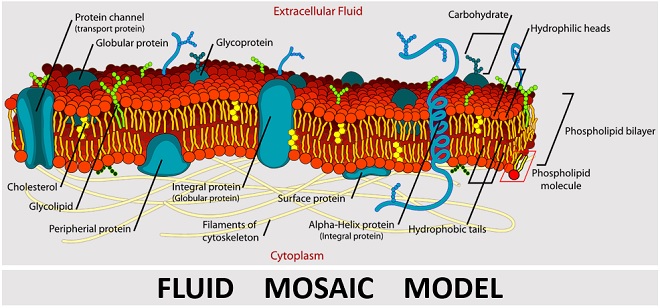
This model represents a very detailed structure and components of the cell membrane, consisting of phospholipids, membrane proteins and carbohydrate molecules. It is also called the “Phospholipid bilayer model”. Now, let us understand the reason why this model named so.
- Fluid: The components of the cell membrane are flexible to move inside the phospholipid bilayer.
- Mosaic: A cell membrane comprises many different molecules like lipids, proteins and carbohydrates that giving a mosaic appearance to the cell membrane.
Therefore, a cell membrane has a complex structure with many components, which we have discussed earlier.
